To Asa Gray 11 May [1863]1
Down Bromley Kent [Leith Hill Place]2
May 11th
My dear Gray
I have to thank you for 2 or 3 little notes.3 The last I was glad to receive on Lyell, & will tell him, when I write, what you say on Species-portion.4 I am pleased at it; but cannot quite agree. You speak of Lyell as a Judge; now what I complain of is that he declines to be Judge. It put me into despair, when I see such men as Lyell & you incapable (as you think) of deciding: I have sometimes almost wished that Lyell had pronounced against me.5 When I say “me”; I mean only change of species by descent. That seems to me the turning point. Personally, of course, I care much about Natural Selection; but that seems to me utterly unimportant compared to question of Creation or Modification.— Like a huge Ass I have written two stupid letters to Athenæum:6 the latter to above effect.— How clever & original & candid your remark about Language & Design.—7
Your little discussion on Angles of Divergence of leaves in a Spire has almost driven me mad.8 My 2d Boy George is a good mathematician, & when I showed him the fractions, he said they formed a converging series;9 & I see when protracted, they do all crowd round one point.

I have been drawing all the real angles & unreal angles on a spire, & I see the angles which do not occur in nature, are just as symmetrical in position as the real angles.10 If you wish to save me from a miserable death, do tell me why the angles of &c series occur, & no other angles.—11 It is enough to drive the quietest man mad.—
Did you & some mathematician publish some paper on subject; Hooker says you did.12 Where is it? I have been visiting for a fortnight houses of relation to try to get a little health for my youngest Boy (the Natural Selection Hero) & self;13 with very poor success. This has led me to muddle my brains over the angles of leaves.— Do you know of any plant in which angle is fluctuating or variable? I often bless science; for when observing I forget my discomfort & at no other time am I comfortable for two successive hours.— Remembering your statements I have been looking at Plantago lanceolata—14 it is a Female Dichogam which is rather rare (ie pistil mature & fertilised long before anthers of same flower mature); fertilised by the wind; and a few plants have imperfect anthers, containing little pollen & a part of this imperfect.—
Euphorbia amygdaloides I find, is also a female dichogamous monoœcious plant, & which is diœcious in function at any one period.15 But why I bother you with these trifling facts, I know not, except that I have nothing to do, & writing to you makes me forget my own odious self.—
Farewell my kind & good friend. If you can spare copy, send me one on De Candolle.16
Farewell— Yours most truly | C. Darwin
Footnotes
Bibliography
Bartholomew, Michael J. 1973. Lyell and evolution: an account of Lyell’s response to the prospect of an evolutionary ancestry for man. British Journal for the History of Science 6 (1972–3): 261–303.
Chambers: The Chambers dictionary. Edinburgh: Chambers Harrap Publishers. 1998.
Correspondence: The correspondence of Charles Darwin. Edited by Frederick Burkhardt et al. 29 vols to date. Cambridge: Cambridge University Press. 1985–.
Gray, Asa. 1849. On the composition of the plant by phytons, and some applications of phyllotaxis. Proceedings of the American Association for the Advancement of Science; second meeting, held at Cambridge, Massachusetts, August 1849, pp. 438–44.
Marginalia: Charles Darwin’s marginalia. Edited by Mario A. Di Gregorio with the assistance of Nicholas W. Gill. Vol. 1. New York and London: Garland Publishing. 1990.
Peirce, Benjamin. 1849. Mathematical investigation of the fractions which occur in phyllotaxis. Proceedings of the American Association for the Advancement of Science; second meeting, held at Cambridge, Massachusetts, August 1849, pp. 444–7.
Summary
CD despairs when men like AG and Lyell consider themselves incapable of judging on change of species by descent.
Is confused over phyllotaxy.
Has been looking at Plantago lanceolata.
Letter details
- Letter no.
- DCP-LETT-4153
- From
- Charles Robert Darwin
- To
- Asa Gray
- Sent from
- Leith Hill Place Down letterhead
- Source of text
- Gray Herbarium of Harvard University (59)
- Physical description
- ALS 4pp
Please cite as
Darwin Correspondence Project, “Letter no. 4153,” accessed on 9 November 2024, https://www.darwinproject.ac.uk/letter/?docId=letters/DCP-LETT-4153.xml
Also published in The Correspondence of Charles Darwin, vol. 11


